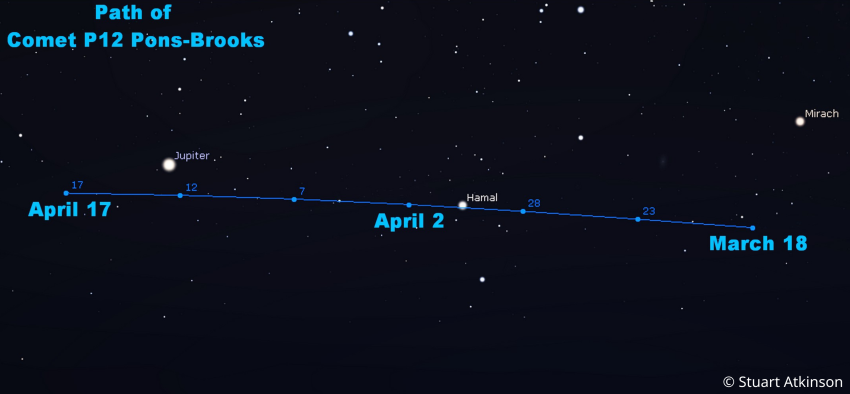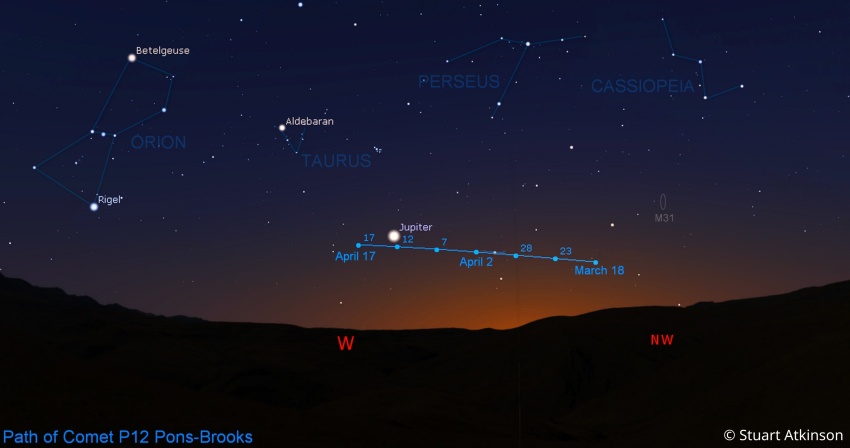A Mount Everest-sized ‘devil’ comet making its first visit to the inner solar system in more than 70 years could be visible to the naked eye over the next few weeks.
The once or possibly twice-in-a-lifetime object, known as 12P/Pons-Brooks, is due to make its closest approach to the Sun on 21 April, which is when it will be at its brightest.
For those in the northern hemisphere, the Halley-type comet is likely to be at its best visibility-wise between now and mid-April, although it won’t be the easiest to spot.
“Don’t expect it to be dazzlingly bright - the kind of image you see in photographs. It’s not going to be like that,” said Dr Robert Massey, deputy executive director at the Royal Astronomical Society.
“This is something that might just be visible to the naked eye if you don’t have a Moon in the sky, if there’s no light pollution and if the weather is really clear, then you might stand a chance.
“But for most of us, we’re going to need to pick up a pair of binoculars."
He added: "Ideally, look at one of the apps you can get on your phone, showing you where things are in the sky, or a finder chart of some kind. That’ll really help you to track it down.
"And when you see it, it’s likely to look like a sort of small, greyish fuzz, quite typical for many comets.
“But you will have the satisfaction of knowing you’ve seen this once-in-a-lifetime object.”
Dr Massey said stargazers should look to the west-north-west after sunset to catch a glimpse of Pons-Brooks, which completes its orbit once every 71.3 years and therefore won’t be visible again until 2095.
The icy body, which is thought to have a nucleus about 34km (21 miles) in diameter, was recognised as a comet in 1812. However, it was seen as far back as the 14th century.
It is named after the French astronomer Jean-Louis Pons - who discovered it in the early 19th century - and British-American astronomer William Robert Brooks, who observed it on its next orbit in 1883.
There has been plenty of interest and excitement about Pons-Brooks over the past few months, driven in part by a couple of unusual features.
Firstly, photographs of its approach have captured the comet’s “curious” green colour.
“That’s because it has a molecule called dicarbon,” Dr Massey explained. “What that does is it absorbs sunlight and re-radiates some of it with that characteristic green tinge.”
The other attribute that has piqued the interest of observers worldwide is its occasional "horned appearance”, earning Pons-Brooks the nickname “Devil Comet”.
The reason these pointy horn shapes appear is because the icy object is classed as a cryovolcanic comet, meaning it regularly erupts with dust, gases and ice when pressure builds inside it as it is heated.
Want to learn more about Pons-Brooks? Watch our explainer video and view the finder charts above.
And if you’re lucky enough to get a picture of the comet, why not share it with us via our social media accounts. You can find us on X, Facebook, Instagram, LinkedIn and YouTube.
Media contacts
Sam Tonkin
Royal Astronomical Society
Mob: +44 (0)7802 877700
Robert Massey
Royal Astronomical Society
Mob: +44 (0)7802 877699
Images and captions
Caption: Comet 12P/Pons-Brooks, which is making its first visit to the inner solar system in more than 70 years, could be visible to the naked eye over the next few weeks.
Credit: Stuart Atkinson
Caption: The Mount Everest-sized comet is due to make its closest approach to the Sun on 21 April.
Credit: Stuart Atkinson
Caption: Pons-Brooks could be visible to the naked eye, but most people will probably need to use binoculars and a finder chart like this one to spot it.
Credit: Stuart Atkinson
Caption: Stargazers should look to the west-north-west after sunset to catch a glimpse of Pons-Brooks, which completes its orbit once every 71.3 years and therefore won’t be visible again until 2095.
Credit: Stuart Atkinson
Notes for editors
About the Royal Astronomical Society
The Royal Astronomical Society (RAS), founded in 1820, encourages and promotes the study of astronomy, solar-system science, geophysics and closely related branches of science. The RAS organises scientific meetings, publishes international research and review journals, recognises outstanding achievements by the award of medals and prizes, maintains an extensive library, supports education through grants and outreach activities and represents UK astronomy nationally and internationally. Its more than 4,000 members (Fellows), a third based overseas, include scientific researchers in universities, observatories and laboratories as well as historians of astronomy and others.
The RAS accepts papers for its journals based on the principle of peer review, in which fellow experts on the editorial boards accept the paper as worth considering. The Society issues press releases based on a similar principle, but the organisations and scientists concerned have overall responsibility for their content.





